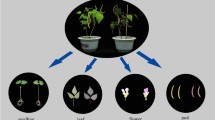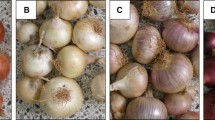Abstract
Bulb color in onions (Allium cepa) is an important trait, and homogenous red coloration is desirable in red onion cultivars. The gene encoding anthocyanin synthase (ANS) is required for anthocyanin biosynthesis in onions. We have previously described three different alleles of the ANS gene. Here we report identification of the fourth allele of ANS, ANS-h1, found in a dark red doubled haploid line. ANS-h1 is similar to a non-functional allele found in Brazilian yellow cultivars except that it has several point mutations and indels throughout the promoter and coding regions, none of which are predicted to inactivate enzymatic activity. F2 and backcross populations originating from the crosses between wild-type (ANS-L) allele-containing red and pink (ANS-p) allele-containing white or yellow parents show a discrete segregation ratio of 3 red to 1 light pink, indicating that the wild-type allele is completely dominant over the pink allele. In contrast, segregating populations derived from the crosses between ANS-h1 allele-containing red and the same white or yellow parents show a gradient of red intensity from light pink to dark red, suggesting that other genetic factors may affect expression of ANS-h1. A newly developed PCR-based marker and two previously developed markers for allelic selection of the ANS gene were used to examine allele composition in fifty-six breeding lines and commercial cultivars. Most lines are heterogeneous for the ANS gene with two or three alleles detected. The frequency of the pink allele is low in red breeding lines, but it is predominant in white and yellow lines.
Similar content being viewed by others
References
Bharti, A. & J. Khurana, 2003. Molecular characterization of transparent testa (tt) mutants of Arabidopsis thaliana (ecotype Estland) impaired in flavonoid biosynthesis pathway. Plant Sci 165: 1321–1332.
Clarke, A.E., H.A. Jones & T.M. Little, 1944. Inheritance of bulb color in the onion. Genetics 29: 569–575.
Dooner, H.K., T.P. Robbins & R.A. Jorgensen, 1991. Genetic and developmental control of anthocyanin biosynthesis. Annu Rev Genet 25: 173–199.
El-Shafie, M.W. & G.N. Davis, 1967. Inheritance of bulb color in the onion (Allium cepa L.). Hilgardia 38: 607–622.
Endt, D.V., J.W. Kijne & J. Memelink, 2002. Transcription factors controlling plant secondary metabolism: what regulates the regulators? Phytochemistry 61: 107–114.
Fossen, T., O.M. Andersen, D.O. Ovstedal, A.T. Pedersen & A. Raknes, 1996. Characteristic anthocyanin pattern from onions and other Allium spp. J Food Sci 61: 703–706.
Goodrich, J., R. Carpenter & E. Coen, 1992. A common gene regulates pigmentation pattern in diverse plant species. Cell 68: 955–964.
Holton, T.A. & E.C. Cornish, 1995. Genetics and Biochemistry of anthocyanin biosynthesis. Plant Cell 7: 1070–1083.
Kim, S., M. Binzel, K. Yoo, S. Park & L.M. Pike, 2004a. Pink (P), a new locus responsible for a pink trait in onions (Allium cepa) resulting from natural mutations of anthocyanidin synthase. Mol Gen Genomics 272: 18–27.
Kim, S., M. Binzel, K. Yoo, S. Park & L.M. Pike, 2004b. Inactivation of DFR (Dihydroflavonol 4-reductase) gene transcription results in blockage of anthocyanin production in yellow onions (Allium cepa). Mol Breed 14: 253–263.
Kim, S., R. Jones, K. Yoo & L.M. Pike, 2004c. Gold color in onions (Allium cepa), a natural mutation of the chalcone isomerase gene harboring a pre-mature stop codon. Mol Gen Genomics 272: 411–419.
Kim, S., K. Yoo & L.M. Pike, 2005a. Development of a codominant PCR-based marker for an allelic selection of the pink trait in onions (Allium cepa) based on the insertion mutation in the promoter of the anthocyanidin synthase gene. Theor Appl Genet 110: 573–578.
Kim, S., K. Yoo & L.M. Pike, 2005b. Development of a PCR-based marker utilizing a deletion mutation in the DFR (dihydroflavonol 4-reductase) gene responsible for the lack of anthocyanin production in yellow onions (Allium cepa). Theor Appl Genet 110: 588–595.
Kim, S., R. Jones, K. Yoo & L.M. Pike, 2005c. The L locus, one of complementary genes required for anthocyanin production in onions (Allium cepa), encodes anthocyanidin synthase. Theor Appl Genet 111: 120–127.
Kim, S., K. Yoo & L.M. Pike, 2005d. The basic color factor, the C locus, encodes a regulatory gene controlling transcription of chalcone synthase genes in onions (Allium cepa). Euphytica 142: 273–282.
Koops, A.J., R.D. Hall & C. Kik, 1991. Bolkleurvorming bij de ui: een biochemisch genetisch model. Prophyta 6: 20–22.
Mol, J., G. Jenkins, E. Schafer & D. Weiss, 1996. Signal perception, transduction, and gene expression involved in anthocyanin biosynthesis. Crit Rev Plant Sci 15: 525–557.
Pike, L. & K. Yoo, 1990. A tissue culture technique for the clonal propagation of onion using immature flower buds. Scientia Hortic 45: 31–36.
Pike, L., 1986. Onion breeding. In: M.J. Basset (Eds.) Breeding Vegetable Crops, pp. 161–176. AVI publishing Co., Connecticut.
Quattrocchio, F., J. Wing, H. Leppen, J. Mol & R. Koes, 1993. Regulatory genes controlling anthocyanin pigmentation are functionally conserved among plant species and have distinct sets of target genes. Plant Cell 5: 1497–1512.
Rieman, G.H., 1931. Genetic factors for pigmentation in the onion and their relation to disease resistance. J Agr Res 42: 251–278.
Shirley, B.W., 1996. Flavonoid biosynthesis: ‘new’ functions for an ‘old’ pathway. Trends Plant Sci 1: 377–382.
Spelt, C., F. Quattrocchio, J.N. Mol & R.E. Koes, 2000. Anthocyanin1 of Petunia encodes a basic helix-loop-helix protein that directly activates transcription of structural anthocyanin genes. Plant Cell 12: 1619–1631.
Yamazaki, M., Y. Makita, K. Springob & K. Saito, 2003. Regulatory mechanisms for anthocyanin biosynthesis in chemotypes of Perilla frutescens var. crispa. Biochem Eng J 14: 191–197.
Author information
Authors and Affiliations
Corresponding author
Rights and permissions
About this article
Cite this article
Kim, S., Bang, H., Yoo, KS. et al. Identification of the fourth allele of the ANS (anthocyanidin synthase) gene and its effect on red color intensity in onions (Allium cepa). Euphytica 149, 45–51 (2006). https://doi.org/10.1007/s10681-005-9053-8
Received:
Accepted:
Published:
Issue Date:
DOI: https://doi.org/10.1007/s10681-005-9053-8




